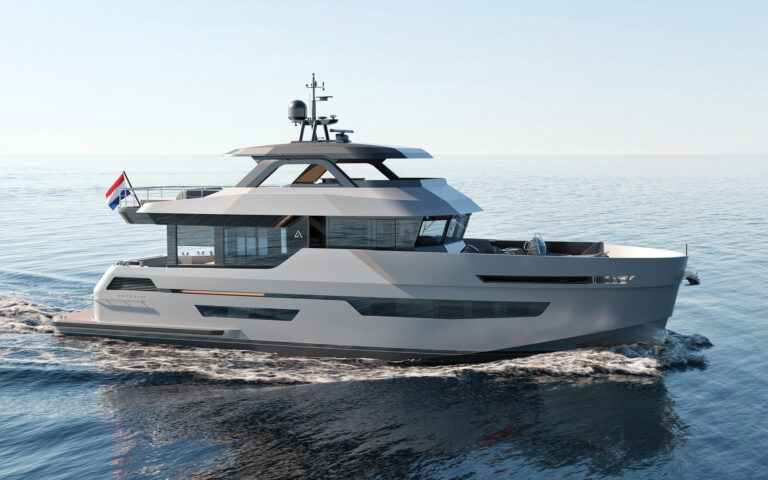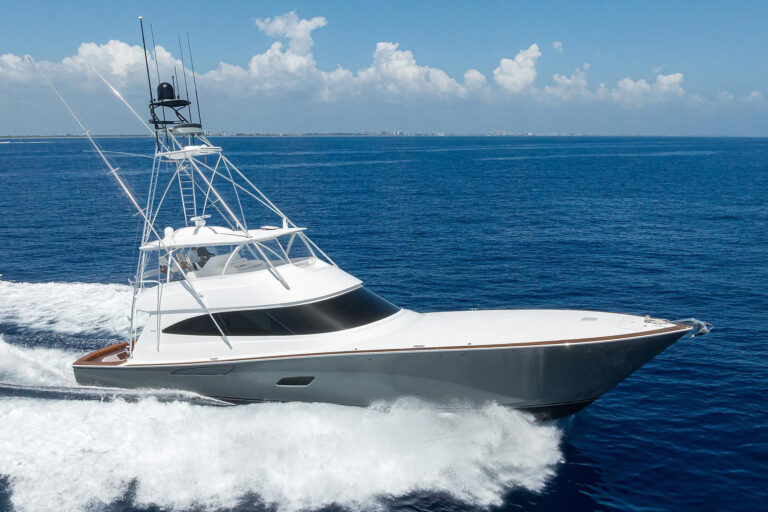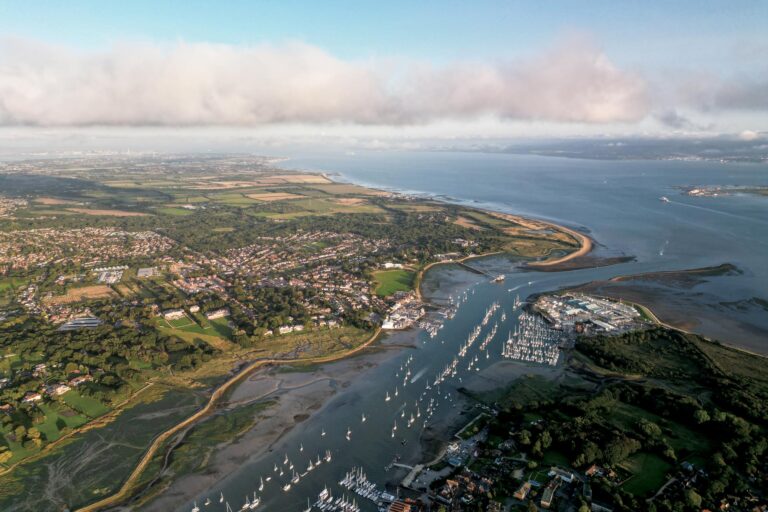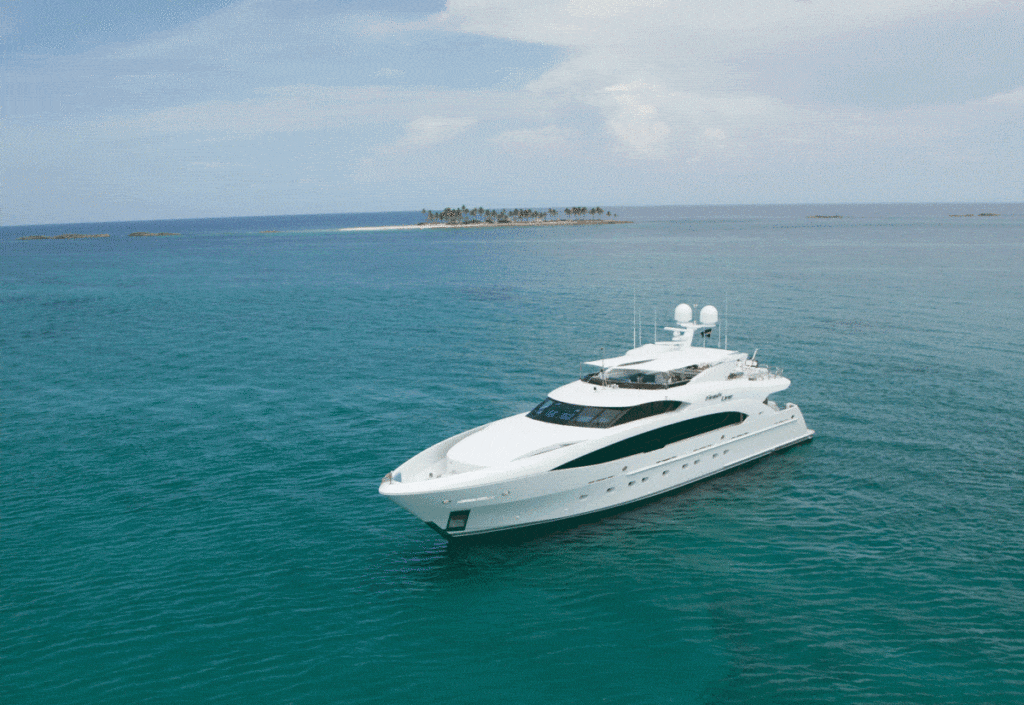
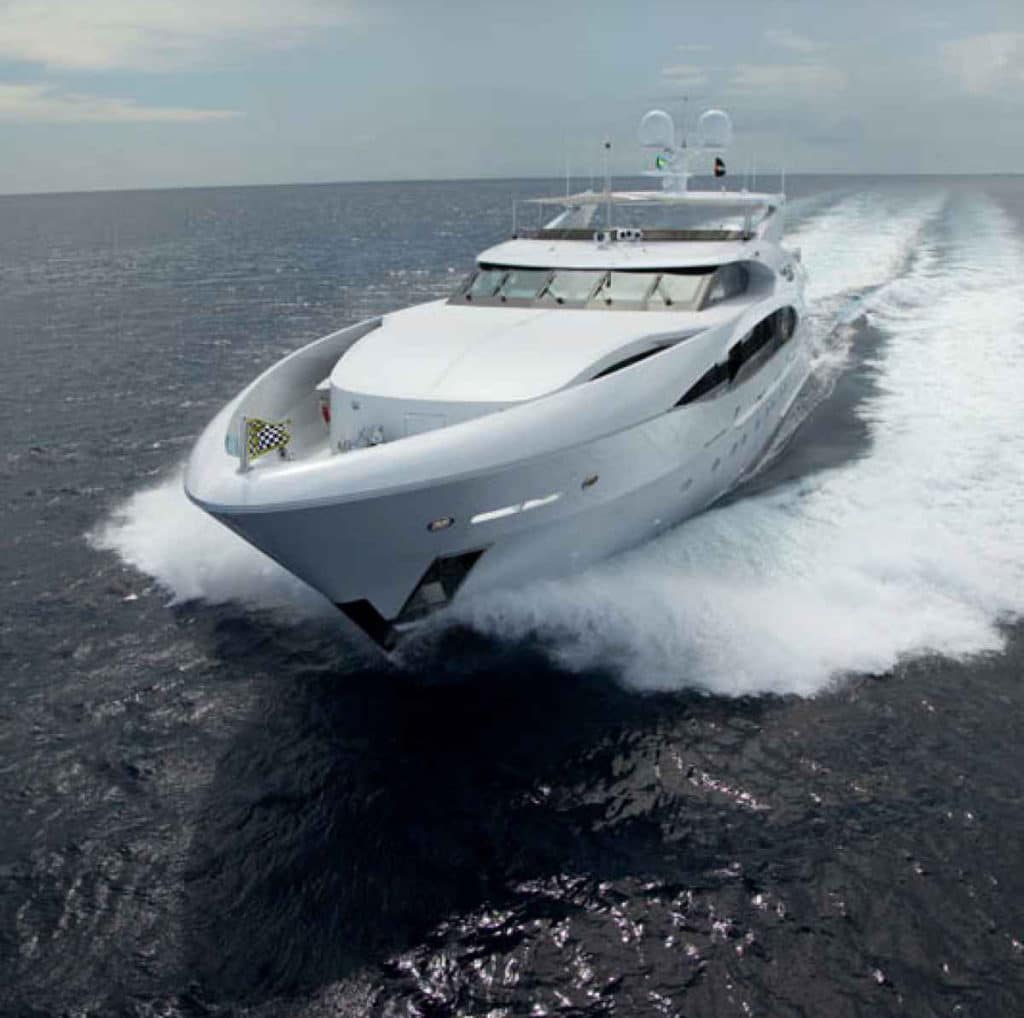
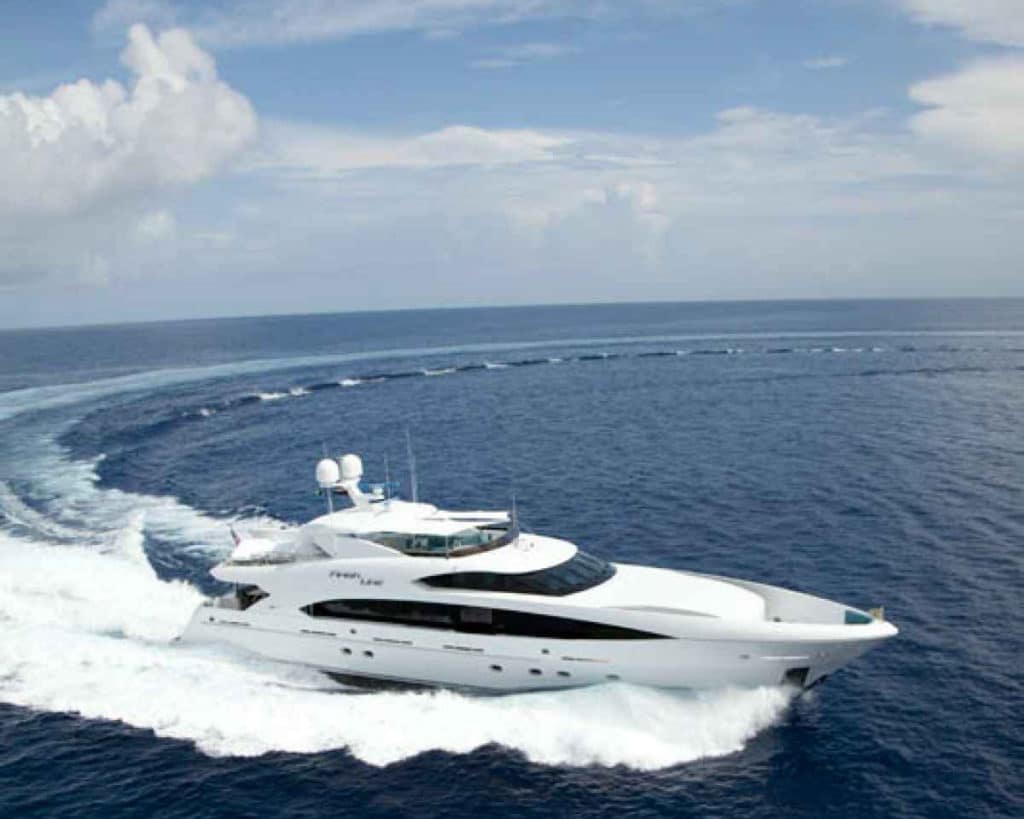
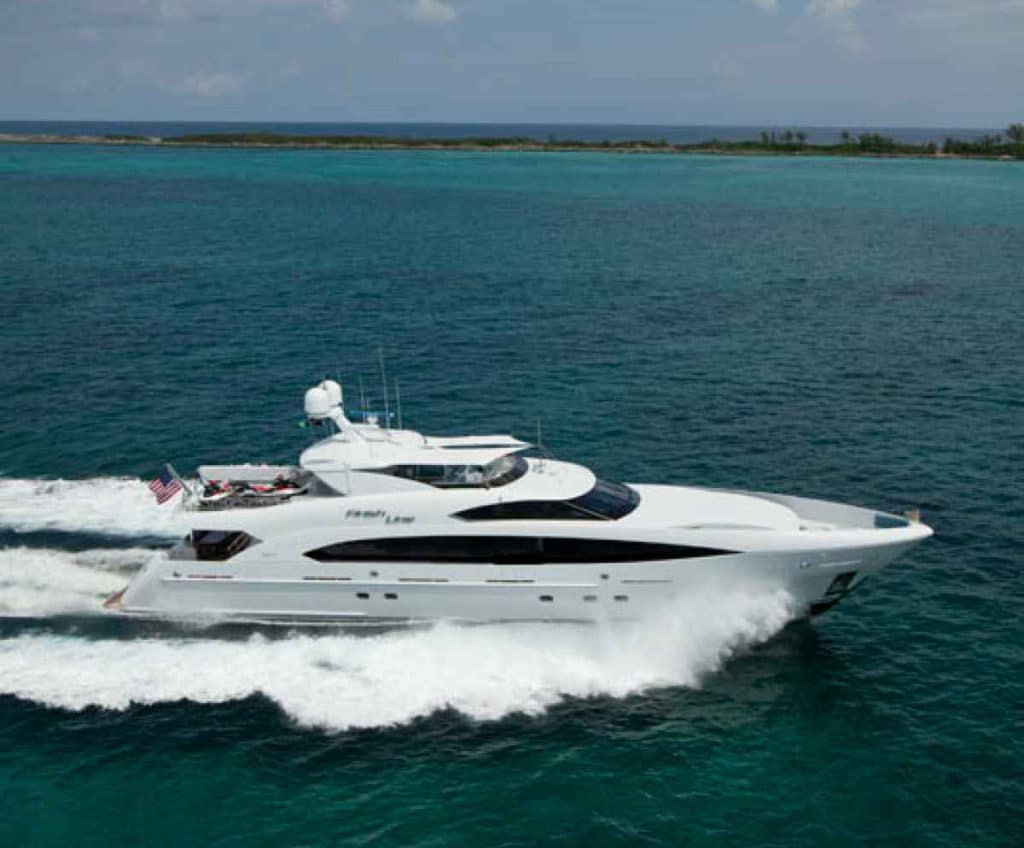
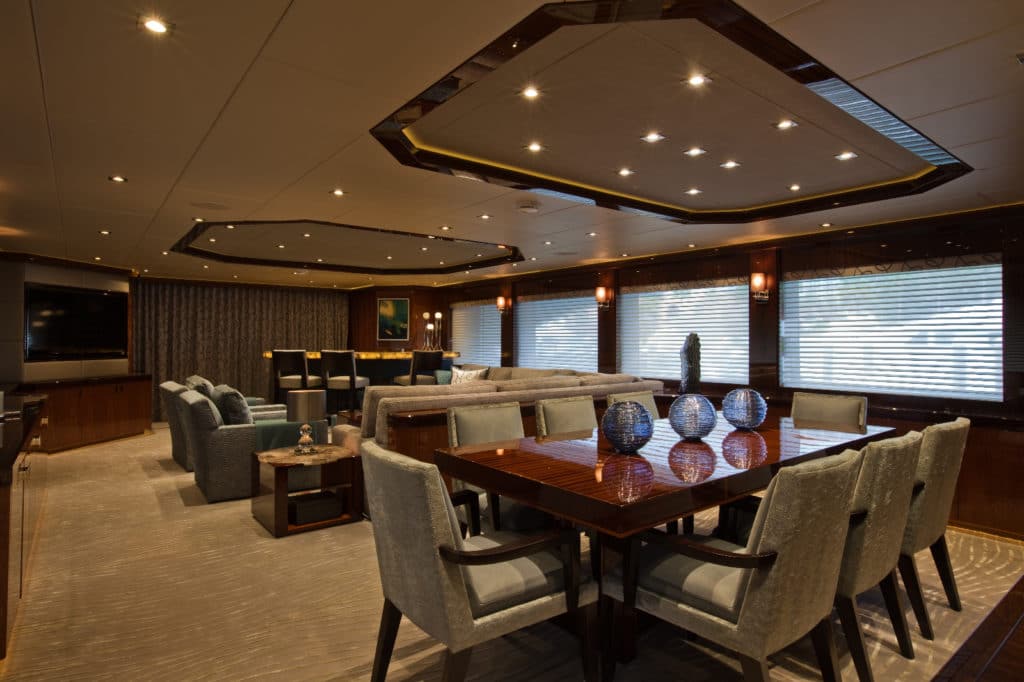
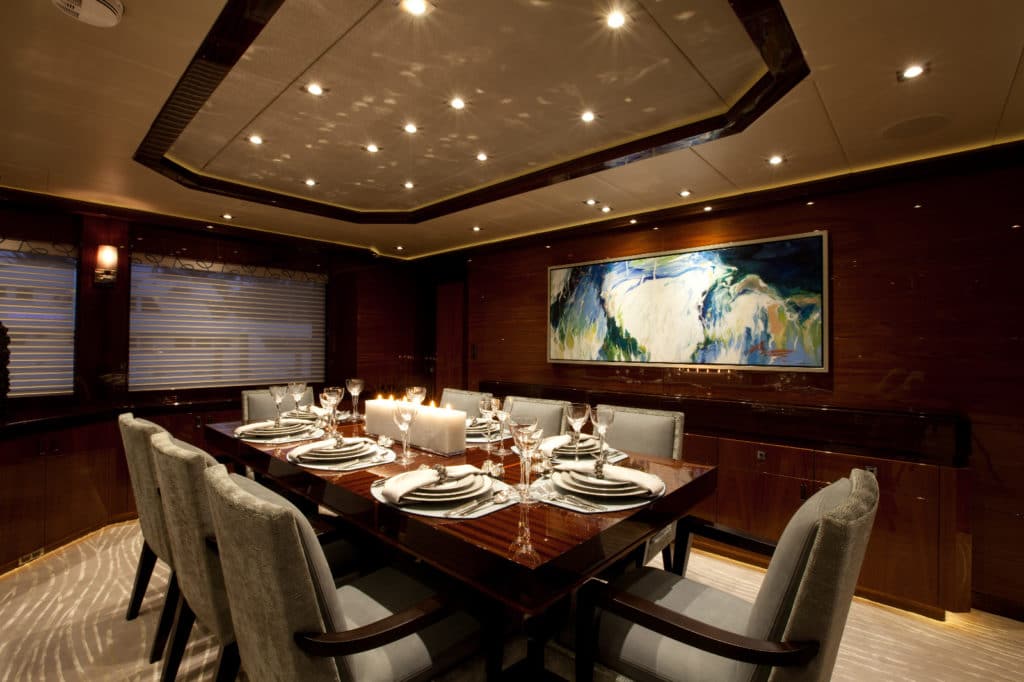
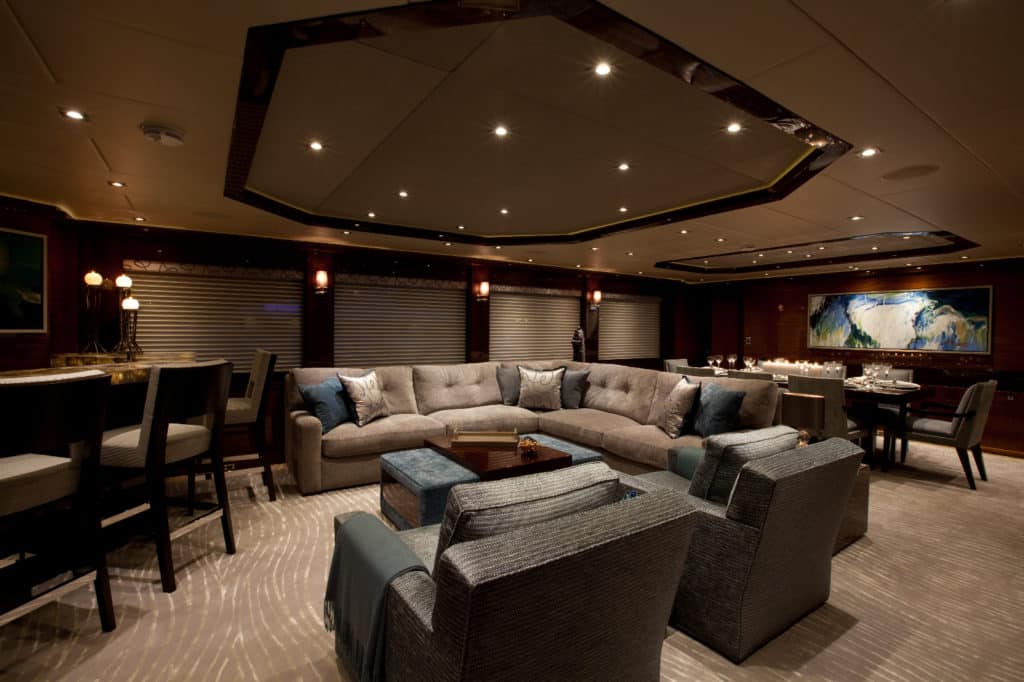
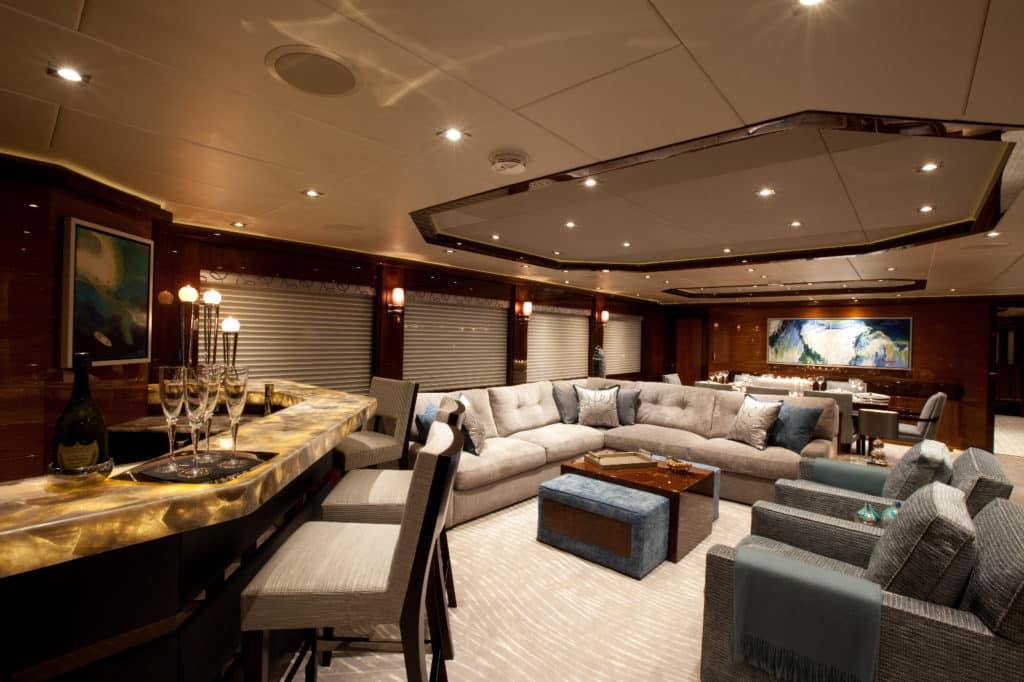
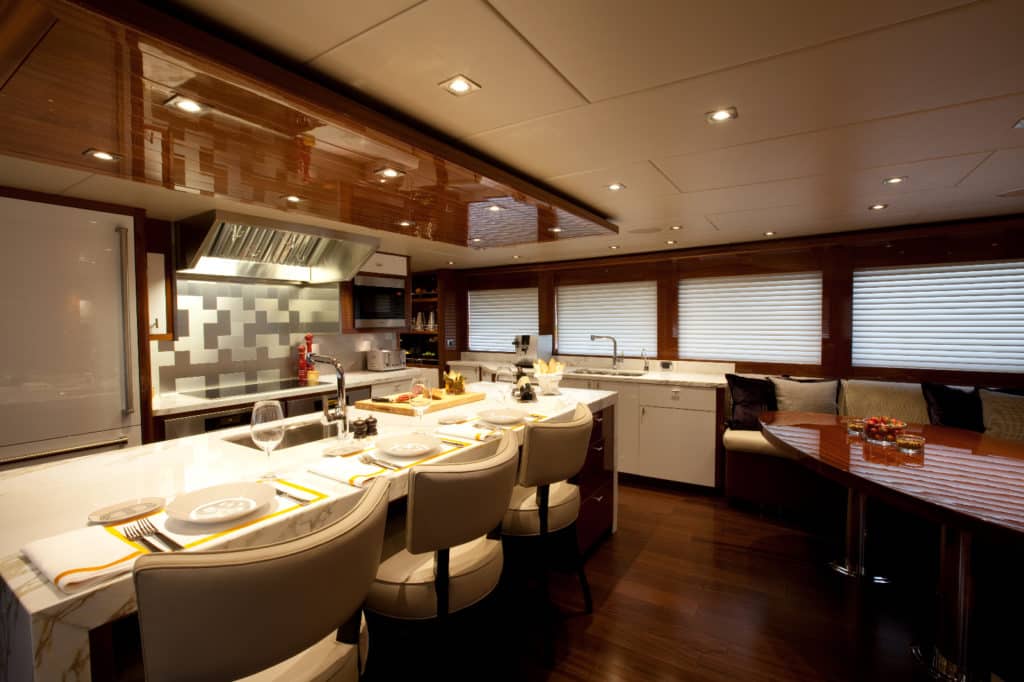
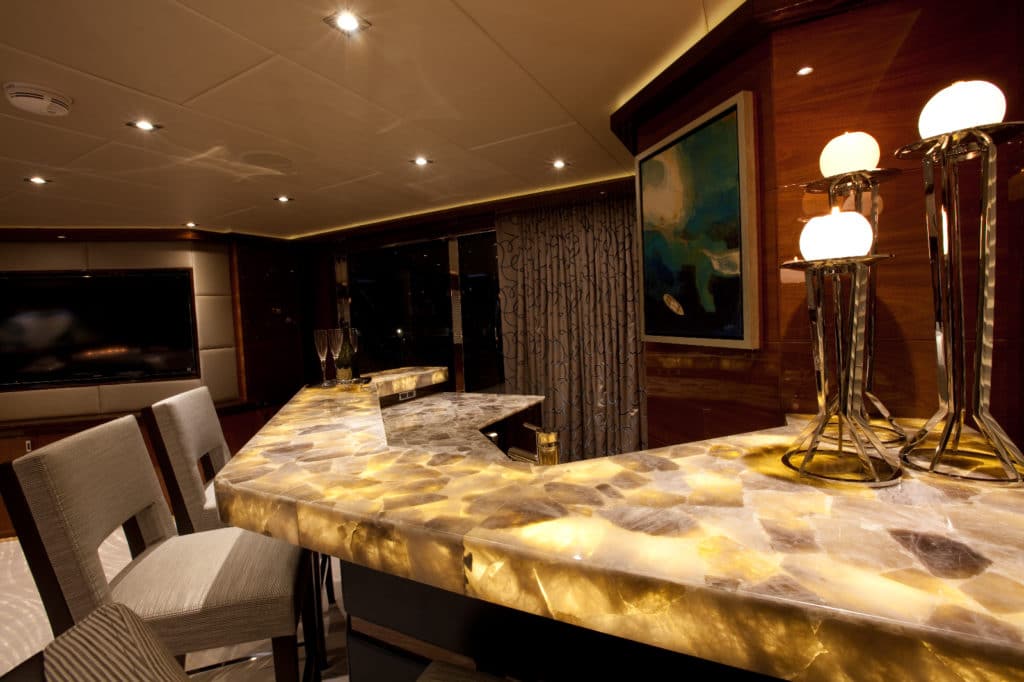
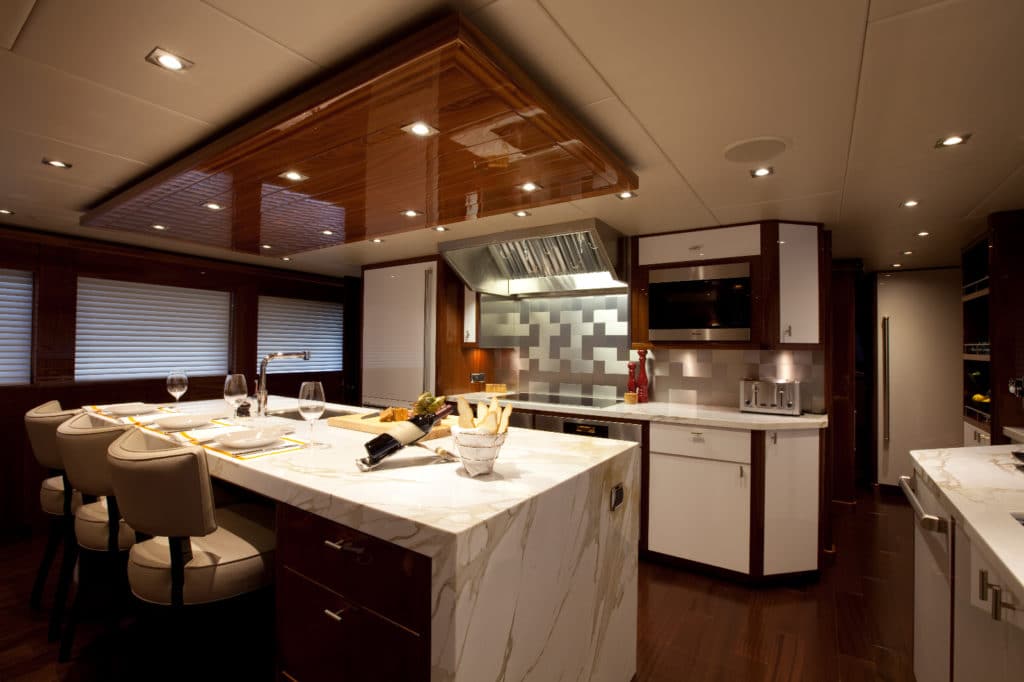
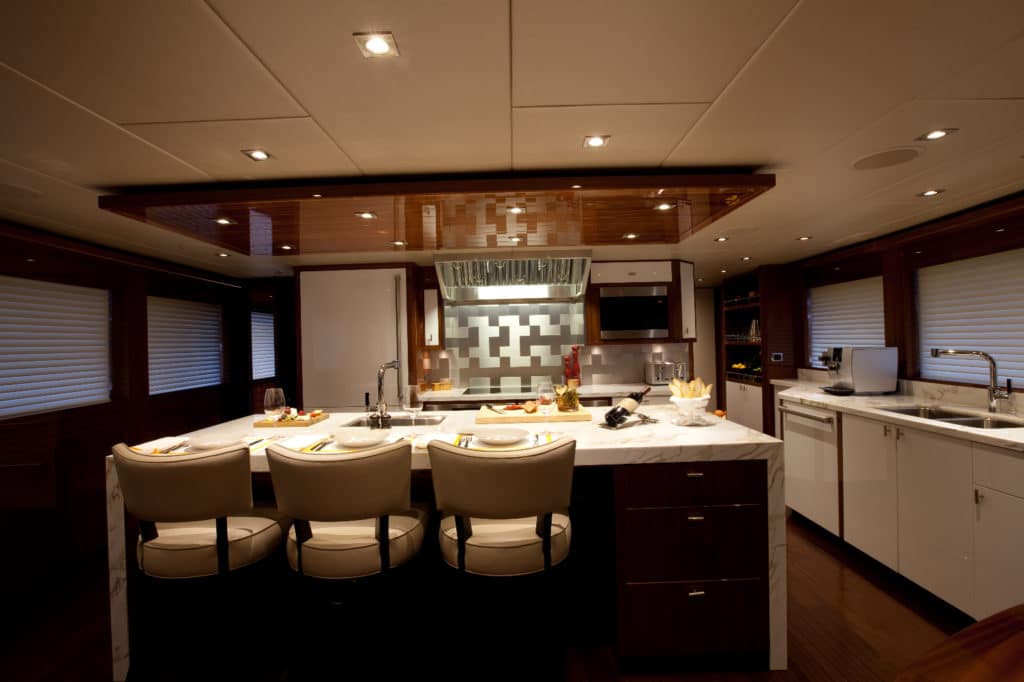
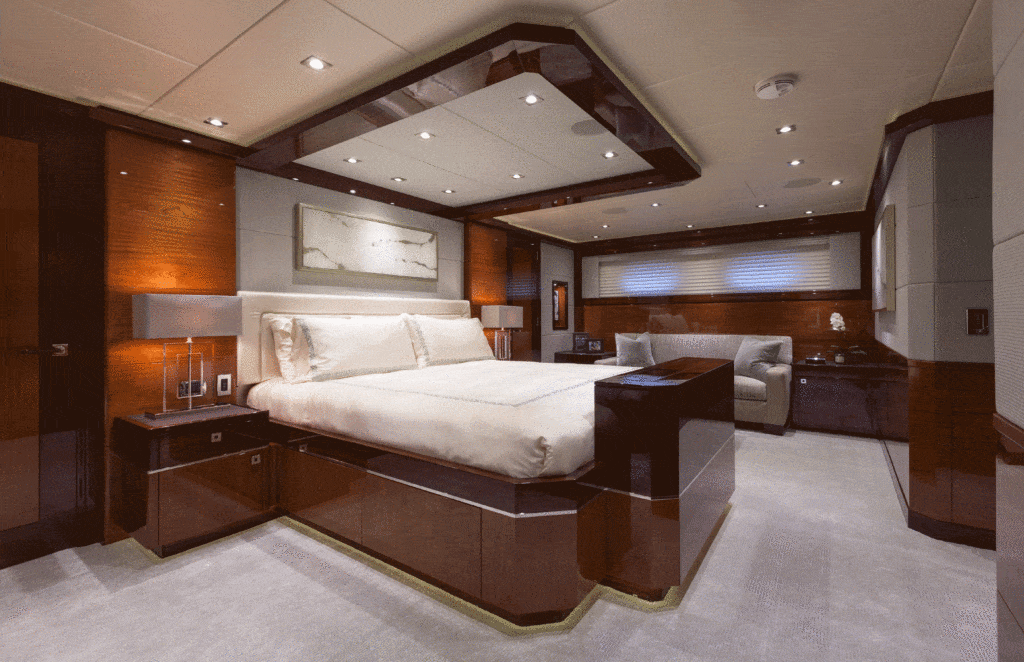
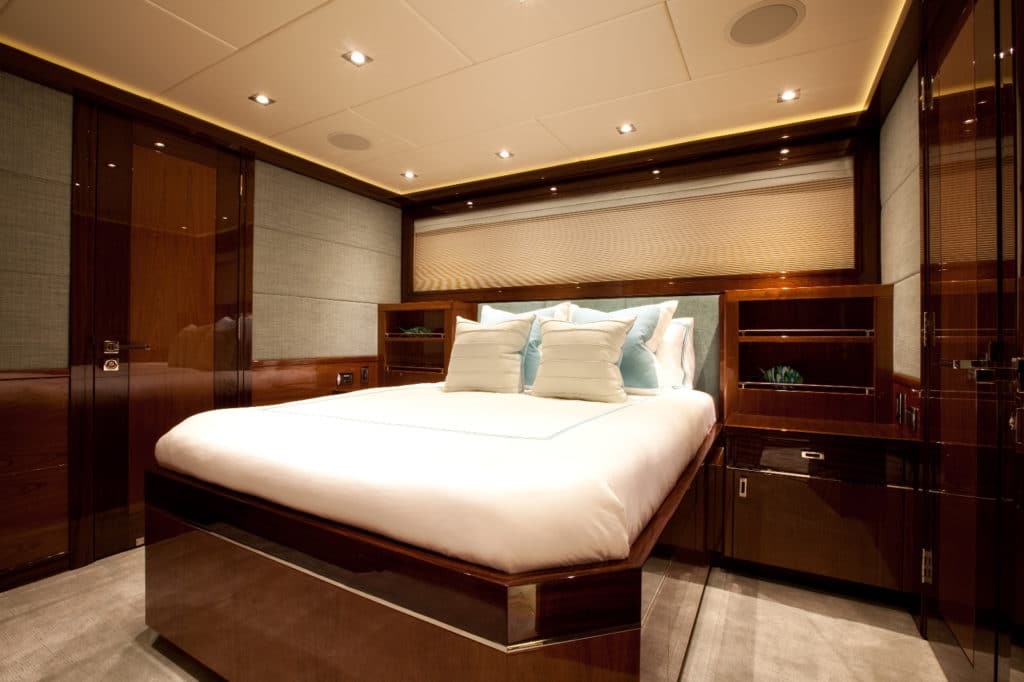
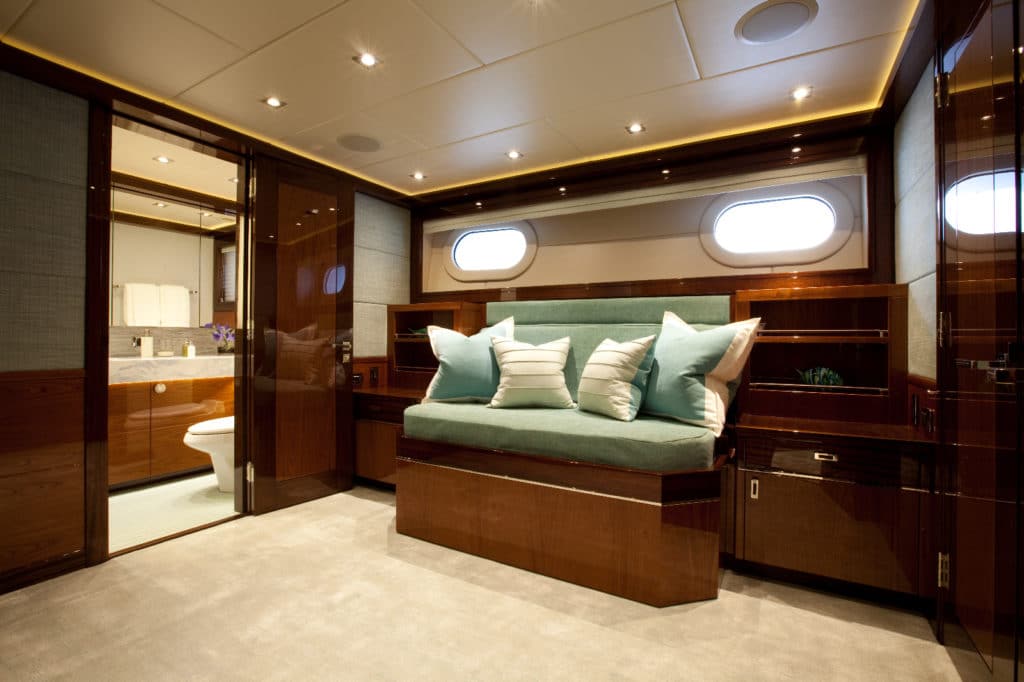
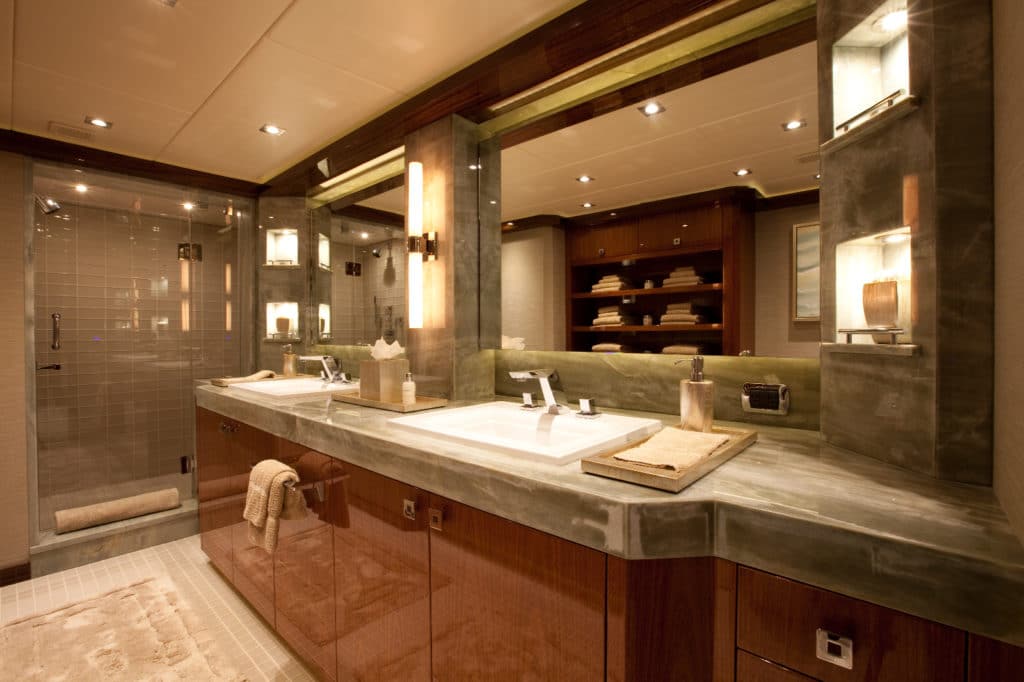
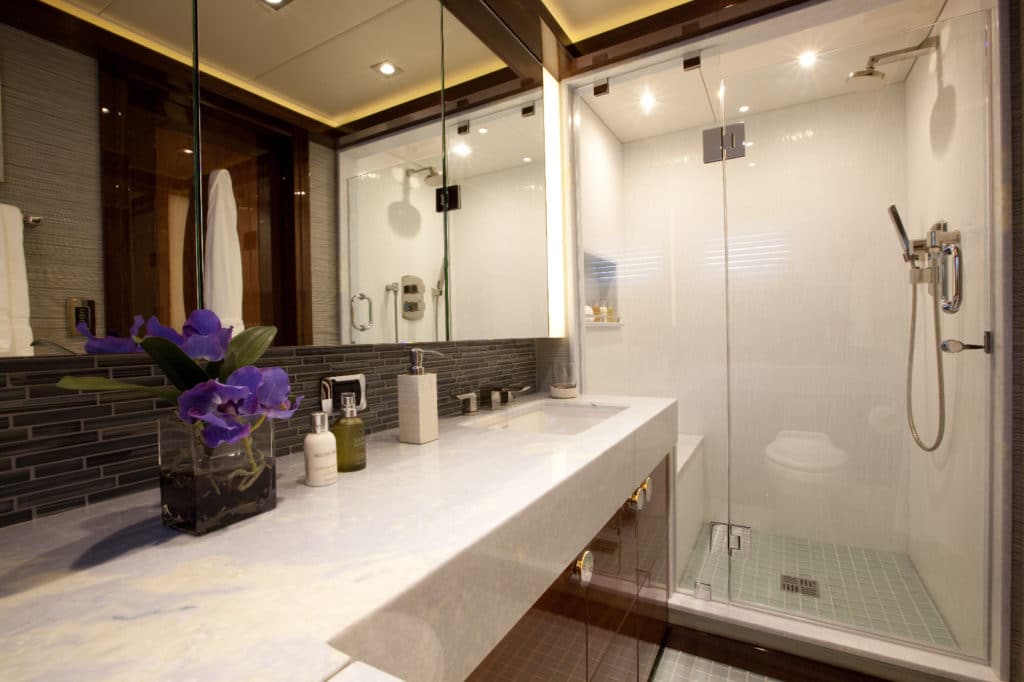
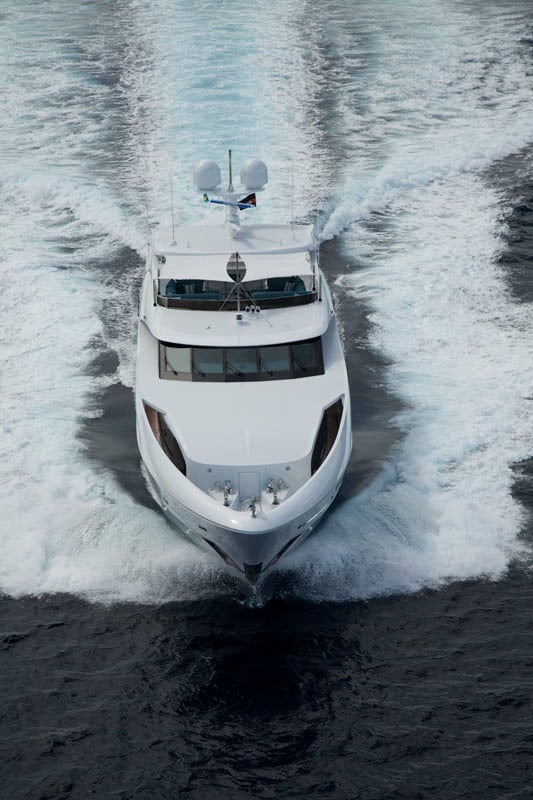
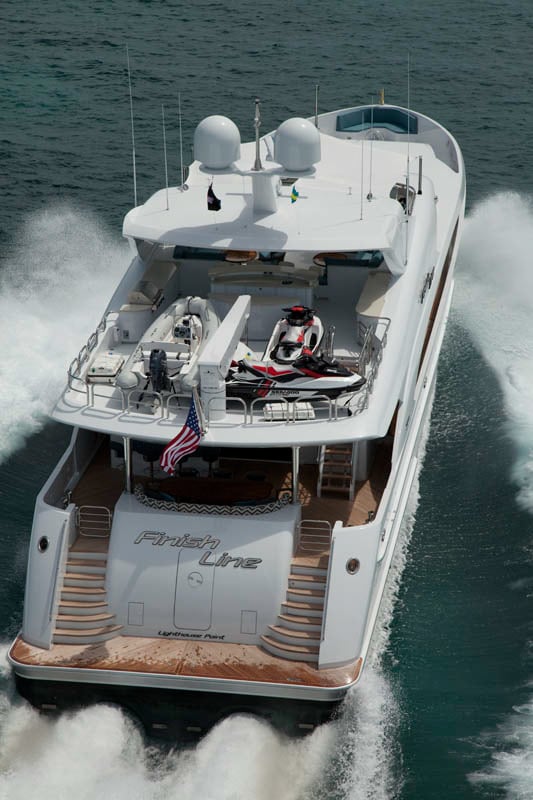
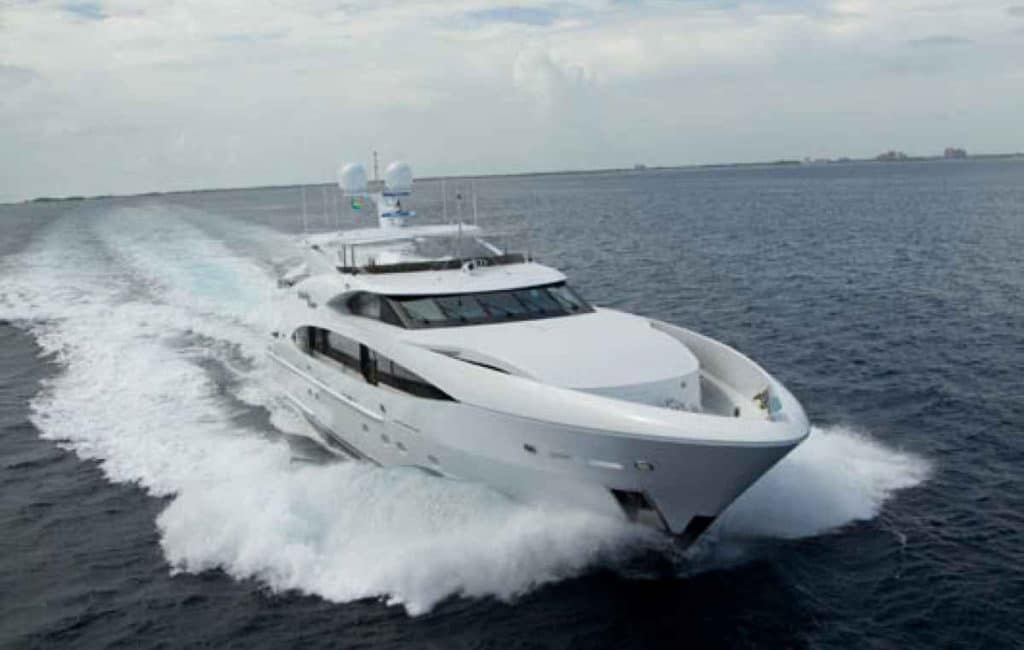
Almost all yachts over a certain length these days are referred to as custom, but many are based on a series design with a few exterior tweaks and an interior that is more custom in decor than in arrangement. The 120-foot Trinity Finish Line is different. She is truly custom, designed from the waterline up to meet the cruising requirements of her owner and his captain.
The most visibly apparent difference from other yachts is in her profile, which is sleek. Finish Line has a raised-pilothouse configuration, something more common on 80-footers than 120-footers. When you stretch the genre another 50 percent, as Finish Line does, the result is an exceptionally low and lean look.
Finish Line sits among other yachts of similar length and looks like a Ferrari among the SUVs at a neighborhood soccer practice. This is no Italian styling exercise, though. She is homegrown, having been sketched in Florida with final design and construction in New Orleans. Capt. Billy Lockhart, who has served this owner for 10 years, put it this way: “We didn’t want just another big box. We didn’t want her to look like a toaster.”
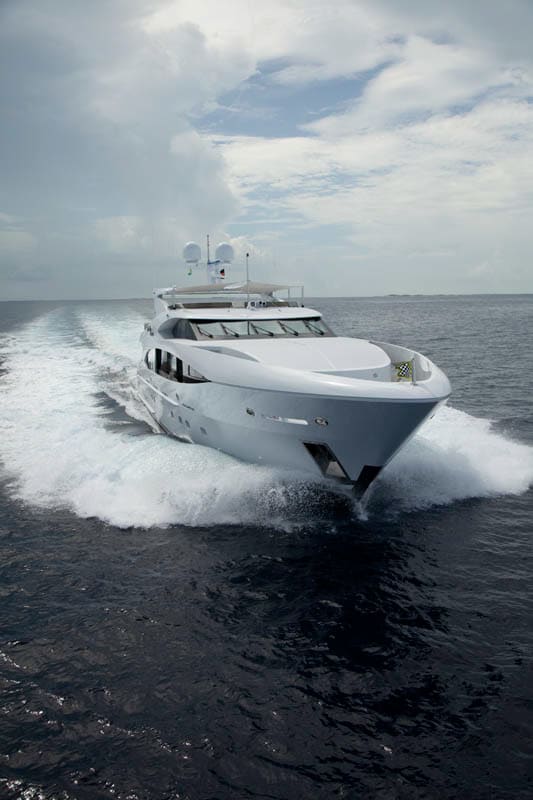
There’s no danger of that. The pilothouse is a bit farther aft, proportionately, than it would be on a shorter yacht. This allows the trunk cabin to slope gently downward while the sheer line rises, with the pair tapering visually to a point forward. The continuous main-deck window line further emphasizes that sharp-as-an-arrow look, while the after end of the pilothouse window echoes that of the larger window below. Happily, no huge hull-side windows interrupt the longitudinal flow of the profile. Even the hardtop above the flybridge received incredible attention during the preliminary planning so it would be part of the whole rather than appearing to be an afterthought, as so many do.
To use Lockhart’s words: Why do some other boats look like toasters? The primary reason is the trade-off between length and interior volume. Many owners want as much bang for the buck as they can get, and bang for most owners means space. Length is expensive, both in initial cost and in continuing assessments such as dockage and haul-out. If you can pack more space into a given length, that lowers the per-square-foot cost of the interior volume. That’s why you see most 120-footers with a trideck configuration, some even with an enclosed fourth deck in place of a flybridge.
Once Finish Line‘s owner decided to build new rather than refit a brokerage boat, says the captain, they sat down with Trinity Vice President Jim Berulis and chief designer Geoff van Aller to list the essential parameters for the yacht. That, and the owner’s willingness to work with the yard to do things right instead of just “good enough,” is what defined her profile and arrangement — and guaranteed her success, both in looks and performance.
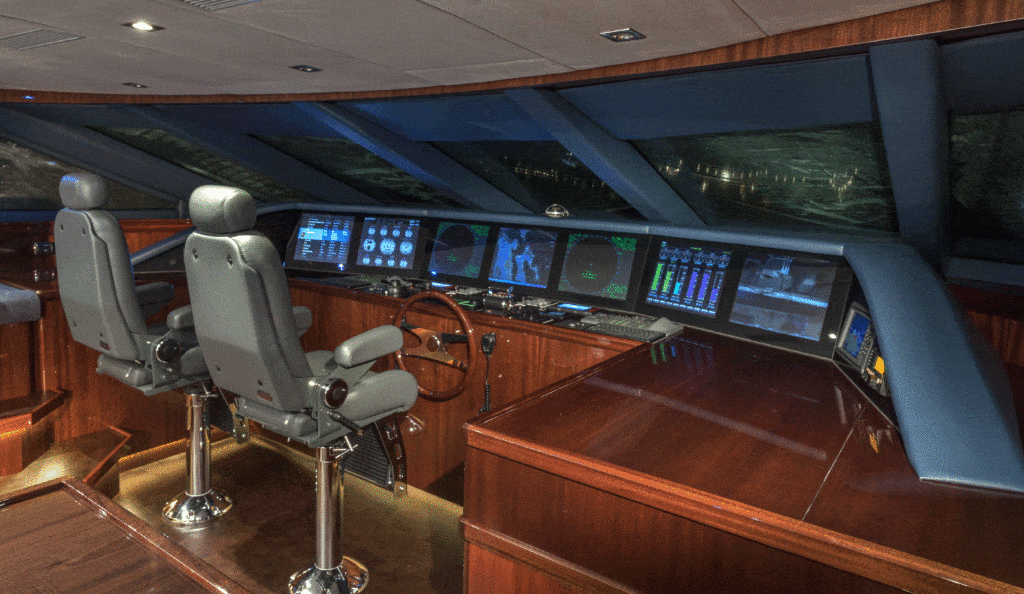
The owner’s two overriding requirements were speed and draft. His life is all about speed, so having a slow boat was not an option. Likewise, his cruising grounds are largely confined to south Florida and the Bahamas, so a modest draft was critical. These two goals often work against each other, with speed requiring lots of horsepower, which means bigger propellers and oftentimes more draft.
One solution is to make the hull wider, providing more buoyancy to carry the displacement with less draft, but width adds to hull resistance and reduces speed. The better solution is to stretch the boat’s length, creating a proportionally narrower hull (a higher length-to-beam ratio, in naval architecture terms). This works only if you can resist the temptation to fill that extra length with more “stuff” such as extra cabins, adding more displacement, which works against achieving the desired speed.
The owner has never offered his previous yachts for charter and does not intend to do so with Finish Line. He also tends to keep his yachts longer than the average owner does. Those two points allow a bit more freedom in the design process, more customization, because it’s not necessary to stick with a generic plan for either charter or quick resale.
On the other hand, the owner is aboard the yacht a great deal for personal and family use, and for business entertaining. These two uses are not always compatible as far as the arrangement plan goes, so some innovation was required. Interior designer Joanne Lockhart of Yacht Next, who was also involved with the exterior styling, is married to the captain and previously served as crew for the owner, so she had a solid understanding of what they hoped to achieve with this boat. The results are exceptional, both in decor and in function.
Finish Line carries only four staterooms, with each having an unusually large amount of open space. Not only does this keep weight down, but it also gives guests the feeling of being aboard a much larger yacht. As I walked through the accommodations, I had the impression of being aboard a 160-footer, and that’s quite a trick. Two queen-berth staterooms are forward, and the port-stateroom berth can be partially stowed into the space behind the headboard, leaving a portion that functions as a sofa. That leaves more open space in the stateroom for the kids to play when Finish Line isn’t carrying a full complement of guests. A third stateroom, also to port, has a split queen berth that can transform into two singles.
The master stateroom is also designed with flexibility in mind. Rather than a common full-beam, his-and-hers head with centerline bath, it has a single head with dual vanities forward to starboard. A hanging locker spans the full beam between the berth and engine room for sound absorption, and is split with a door on centerline.
When the owner is not aboard but additional guests are, the door allows the owner’s belongings to be moved to one side and locked away, leaving the other side for guest use.
| Specifications | Builder Supplied Number |
|---|---|
| LOA: | 120’7″ |
| BEAM: | 26’2″ |
| DRAFT: | 5’6″ |
| DISPL.: | 187 long tons (light ship) |
| FUEL: | 9,789 gal. |
| WATER: | 2,466 gal. |
| HOLDING: | 268 gal. black, 195 gal. gray |
| CONSTRUCTION: | Aluminium |
| NAVAL ARCHITECT: | Trinity Yachts |
| INTERIOR DESIGN: | Yacht Next (Joanne Lockhart) |
| GENERATORS: | 2 x 80 kW Kohler |
| STABILIZERS: | Arcturus TRAC |
| BOW THRUSTER: | 100 hp Arcturus TRAC |
| ENGINES: | 2 x 2,600 hp MTU 16V 2000 M94 |
| SPEED: | 23 knots max |
| RANGE: | 3,670 nm at 10 knots |
| PRICE: | Upon request |
The main deck carries a formal dining area as part of the salon, available for entertaining guests. The family, however, enjoys a more casual lifestyle, so the sizable dining area in the country kitchen forward gets frequent use, as do the dining table and bar on the open aft deck. The “designer galley,” in the captain’s words, hints at the collaboration of an experienced owner, a caring captain and a clever designer. The glamour is there, with white marble and top-quality appliances, but so is the function. For instance, the refrigerators, freezers and ovens all are situated so their doors open forward, meaning their contents won’t fall out when opened after some time at sea. The wine locker is split: the top for reds at one temperature, the whites in drawers below at another temperature.
Topside, the flybridge has a full helm to starboard and a wide companion seat to port. Two sitting areas and another bar provide shaded relaxation for as many as 16 guests. Tenders and toys are stowed aft, handled by a centerline crane.
After years of seeing yachts in this size range that were all starting to look the same, inside and out, I found Finish Line a pleasant change of pace. She looks as sleek as a swimsuit model, she lives like a much larger yacht, and, Capt. Lockhart says, she handles like a sport yacht. Proud of her all-American heritage — designed, built and outfitted entirely in the States, and flying the Stars and Stripes — the captain smiles as he says Finish Line was also built on time and “nearly on budget,” lauding [Trinity Yachts][] without reservation. Perhaps he says it best when he describes his charge as “a really big little boat.”
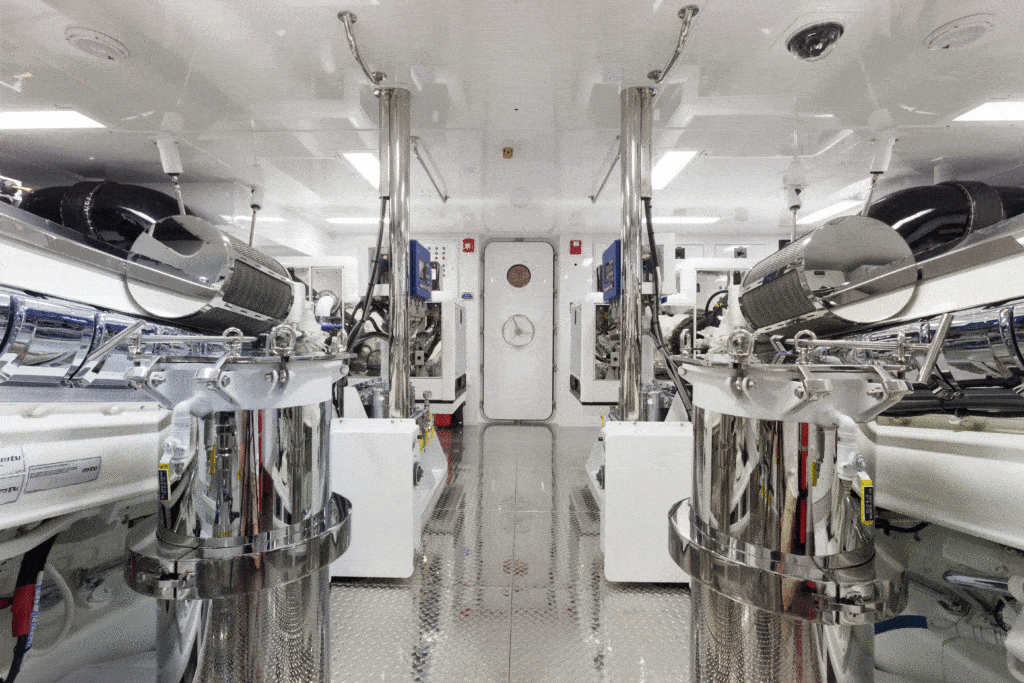
Gentlemen, start your engines!
Daytona Beach, Florida, home of NASCAR’s headquarters, is the unchallenged mecca of speed: The air smells strongly of fuel and rubber, and even the hotel parking lots have skid marks. In the October 2005 issue of YACHTING, I authored an article about the NASCAR Yacht Club, a group of racing’s elite including Jeff Gordon, Dale Earnhardt Jr. and others who escape their fast lives by traveling aboard their yachts. The piece included tips on how to spot a yacht whose owner is affiliated with the auto-racing circuit. Finish Line, both by name and by the NASCAR flag flying prominently from her mast, is a front-row qualifier. Indeed, speed was one of two items that drove her design. She is powered by two MTU 16V 2000 diesels fitted with oversize M94 injectors that pass enough extra fuel to push the motors to 2,600 horsepower each at 2,450 rpm. That extra fuel requires extra air for combustion, so each engine is fitted with three turbochargers. They operate sequentially, the second kicking in when the first reaches 80,000 rpm, the third when the second reaches that same point. They kick off line, again sequentially, at 60,000 rpm, so a number of “sweet spots” are attained by running her up and then backing off a bit, much like getting a smaller boat on plane and then pulling back on the throttle. Through 5-inch shafts, the engines spin 53-inch Veem six-blade propellers fitted with slotted “cup” inserts for even finer tuning. Finish Line made 24 knots on sea trials, pushes 23 knots now that she’s fully outfitted and regularly cruises at 20 knots. In the Army, they say, “If it moves, salute it. If it doesn’t move, paint it.” Well, replace “paint” with “chrome,” and you’ve got Finish Line’s engine room. It is a sparkling showcase of chrome, and where chrome won’t do, as with the diamond-patterned deck plates, mirror-polished stainless steel takes over for added durability. No question, Finish Line is a gearhead’s dream come true.






